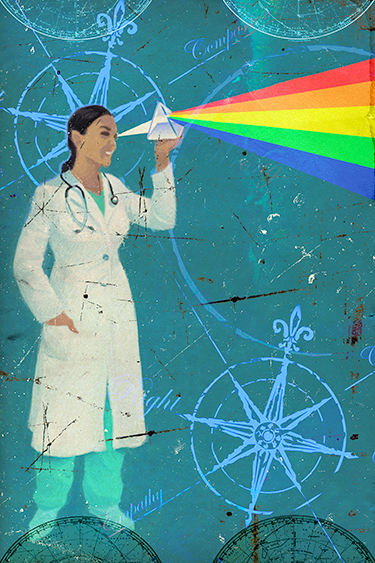Discoveries
Equity Investment
Oct 25, 2017 Linda Burnes Bolton, DRPH, RN
All the best medical centers strive for health equity — but it cannot be achieved through lip service. We must embrace a deep understanding of the concept and teach it to the next generation of caregivers.

Illustration: Anthony Freda
When I was growing up in Tucson, Arizona, my sisters, brothers, and I would walk home from school, meeting at Big Mama’s — my grandmother’s house — on the way. We had to dodge rattlesnakes, yes, but otherwise our walk to and from school was safe. Such freedom to walk around safely is not guaranteed for all children, particularly in big cities. And a lack of safety can make it harder for a child to stay healthy.
Urban environments can contribute to inequity as well: Rodents and carcinogens in an apartment building deprive residents of optimal health. Hispanic, Asian, and black adults have higher rates of diabetes than their white counterparts. A U.S. resident without a high school diploma can expect to die nine years sooner than a college graduate. The barriers to good health are numerous — and they are everywhere.
We can only hope to achieve a rich society — culturally and economically — if every individual can fulfill their potential. If some fall behind, we all lose. At this moment, Cedars-Sinai is in the process of expanding our footprint to include affiliates from Playa Vista to the San Fernando Valley. As we grow our role as a true health resource for the community at large, it is more important than ever to strive to serve everyone equally.
Fortunately, it’s considered necessary and obvious at leading academic medical centers like Cedars-Sinai that the many races and nationalities of the people we serve should be treated equally and with respect. This, however, is only the beginning of health equity. Its endpoint is far more nuanced and difficult to achieve.
The nation’s largest philanthropy dedicated solely to health, the Robert Wood Johnson Foundation, gets to the heart of the matter, stating, “Everyone has a fair and just opportunity to be healthier.” This means enabling each individual to live their healthiest life. In an equitable world, obstacles that restrict access to healthcare — poverty, social injustice, language barriers — would be stripped away.
Identity often is culturally bound, but even individuals of the same background have different priorities, and it is incumbent upon caregivers to honor them.
Cedars-Sinai and institutions like it have a huge and necessary role to play in helping individual communities and our country attain equitable conditions. Health systems have to not only be devoted to snuffing out disease but to supporting a framework that enables human beings in all walks of life to sustain health.
Recently on morning rounds, I talked with two different families, each in the process of transitioning a loved one from the hospital to their home. A family of Chinese origin told me they would be stopping by their favorite Asian market so that when Mom arrived home, she finally could eat a familiar meal. The grandchildren of a Latino patient were looking forward to reuniting their grandmother with her beloved dog. Evidence from multiple studies tells us that if we perform these transitions in care well, patients won’t bounce back to the emergency department and return to a hospital bed. In order to support individuals in their transition, it is vital to see them, not their disease.
Identity often is culturally bound, but even individuals of the same background have different priorities, and it is incumbent upon caregivers to honor them. That role starts with training. At Cedars-Sinai, an inclusive mindset is introduced on the first day of new caregiver’s orientation. Our list of nursing values includes global awareness — the appreciation that people come from myriad backgrounds. Culturally conscious education programs — classes, lectures, and rounds — are offered to all clinical staff, from new hires to senior faculty.
Health equity also can be boosted by reaching outside our walls to help communities evaluate their needs and meet their goals. Cedars-Sinai’s Community Clinic Initiative offers programs to strengthen leadership and effectiveness in local health centers, and provides grants to help clinics thrive. In this way, we reduce barriers and encourage health by meeting diverse populations where they are — on their own geographical and cultural turf.
Everyone who interacts with patients at a large, urban health system like ours can benefit from the principles of inclusion that bring us all closer to health equity. Educational resources are abundant here, but unfortunately are scarce at less well-funded institutions.
As fine a job as we and our peer institutions are doing, we can do even better. Continuing to remove barriers to health and helping all individuals achieve a state of wellness is going to require partnerships, not only with health consumers, but also with businesses, nonprofits, and government. It will require that all partners abandon the comfort of their siloes and engage in a cross-disciplinary effort that navigates our diverse communities.
Any organization that believes in the possibility of wellness for all individuals can and should participate in efforts to achieve health equity. Healthcare cannot happen in a vacuum, but with true cooperation, we can raise the bar for health for all members of our society.
About Dr. Burnes Bolton
Burnes Bolton serves as health system senior vice president for Nursing, chief nursing executive, and director of Nursing Research, and is the James R. Klinenberg, MD, and Lynn Klinenberg Linkin Chair in Nursing at Cedars-Sinai.
In addition, she has served as president of the American Academy of Nursing, the American Organization of Nurse Executives, and the National Black Nurses Association. She also was vice chair of the Institute of Medicine Commission on the Future of Nursing, and chair of the Robert Wood Johnson Foundation committee on Transforming Care at the Bedside


